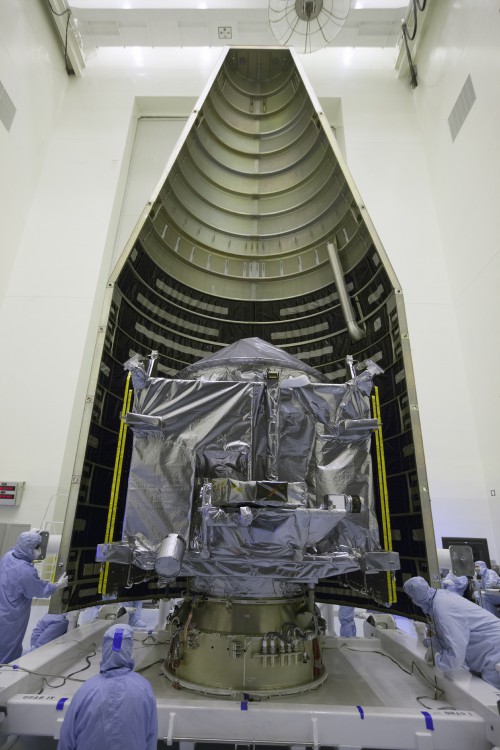
With less than two weeks before the launch window opens for NASA’s next mission to Mars, work continues at Cape Canaveral Space Launch Complex 41 (SLC-41) to ready for a Nov. 18 launch attempt, and early this morning the launch team hoisted the 5,400-pound, fully fueled MAVEN spacecraft atop its Atlas-V rocket launch vehicle. The milestone processing event marks a significant moment in MAVEN’s long journey to Mars—one which began a decade ago.
The spacecraft, already encapsulated in a protective 4-meter-diameter payload fairing for the launch, was moved from the Kennedy Space Center Payload Hazardous Processing Facility to SLC-41 atop a specialized payload transporter shortly after midnight Friday morning. The spacecraft arrived at SLC-41 less than three hours later, where the team quickly began the delicate task of hoisting MAVEN via crane into the Vertical Integration Facility for placement atop the Atlas-V rocket which will thunder away from Earth and throw MAVEN on a one-way trip to Mars.

The spacecraft is ready to fly, and according to United Launch Alliance so is their Atlas-V rocket. On Oct. 29 teams rolled the rocket out to its launch pad and performed a full countdown dress rehearsal, fueling the vehicle and verifying that both the Atlas-V first stage booster and its upper stage Centaur engine are ready to fly. The launch countdown test, with the rocket fully loaded with liquid hydrogen, liquid oxygen, and RP-1 fuel, went as expected and ended at T-0 with no problems reported.
The rocket’s first stage booster was hoisted vertical inside SCL-41′s Vertical Integration Facility on Oct. 11, and the rocket’s upper stage Centaur was hoisted atop the core booster on Oct. 14. A Combined Systems Test, which is an electrical test of the rocket, was conducted on Oct. 22 with no problems reported.
MAVEN’s move to the launch complex was delayed from Thursday, Nov. 7 due to a leak discovered in a ground system gaseous purge line at SLC-41. The minor delay allowed technicians time to complete troubleshooting and repair activities for the ground system leak.
The spacecraft itself has already passed numerous tests, and even more reviews, as the clock ticks toward launch day. Thorough tests of software and hardware systems, inspection, and cleaning of the solar panels, verification tests of the various spacecraft subsystems and payloads, and readiness reviews have all been completed. On Oct. 22 engineers and technicians performed a dry spin test on the spacecraft, rotating MAVEN up to 10 times per minute to verify that the spacecraft is properly balanced as it spins during initial mission activities. A few days later, on Oct. 25, the spacecraft was fueled with 431 gallons of highly toxic hydrazine, which MAVEN will use as a propellant for control and trajectory adjustments during its 10-month journey, or “cruise phase,” to the Red Planet.
MAVEN will only actually need very little of its fuel for the cruise phase itself, as thrusters on the spacecraft will only fire to adjust MAVEN’s flight path during the cruise and approach phases of the flight. Most of the fuel will be conserved for MAVEN’s arrival at Mars in September 2014, when it will need most of that 431 gallons to place itself into position for orbit insertion and to perform orbital correction maneuvers once at Mars. The fuel will also help MAVEN maintain a correct elliptical orbit throughout the mission and will boost the satellite into a higher elliptical orbit at the end of its mission to relay data from other spacecraft (including the Curiosity and Opportunity rovers) currently exploring the surface of the Red Planet.

The spacecraft, now sitting snugly atop its 188-foot-tall Atlas-V launch vehicle, will be powered up for a health check Saturday (Nov. 9), and teams will perform an Integrated Systems Test the following Monday (Nov. 11) to verify that the spacecraft and its rocket are working together and functioning as expected. Several communications tests will be conducted with the spacecraft between now and launch to ensure MAVEN is in fact healthy when its violent launch begins.
NASA’s $670 million Mars Atmosphere and Volatile Evolution mission (MAVEN) will have its first chance to launch on Nov. 18 at 1:28 p.m. EST, with a two-hour launch window available on each day during a three-week launch window. Once launched, MAVEN will take 10 months to push through the emptiness between our worlds, arriving at Mars on Sept. 22, 2014 (assuming MAVEN launches on Nov. 18). It will take five weeks for the spacecraft to get into its final science-mapping orbit, test the instruments, and test science mapping sequences. MAVEN will then be ready to begin its one-Earth-year primary mission.
“MAVEN is going after something the others haven’t,” said David Mitchell, MAVEN’s project manager for NASA’s Goddard Spaceflight Center in Maryland. “It’s going to look at the current composition of the upper atmosphere and how solar storms and other factors changed the atmosphere. We’ll then be able to project back in time to see how it was in an earlier epoch. Scientists believe the planet has evolved significantly over the past 4.5 billion years. It had a thicker atmosphere and water flowing on the surface. It wasn’t like Earth, but it was not like it is today. Ultimately, the mysteries that MAVEN will help decipher should be a treasure trove for the science community.”
Want to keep up-to-date with all things space? Be sure to “Like” AmericaSpace on Facebook and follow us on Twitter: @AmericaSpace
Missions » MAVEN »



From Mariner 4 to MAVEN, the exploration of Mars has yielded (and will yield) ever more tantalizing information about the Red Planet. The mission will provide invaluable clues to help scientists eventually determine conditions on the exoplanets that are being discovered at an accelerated pace. Mars is precisely the model “laboratory!”